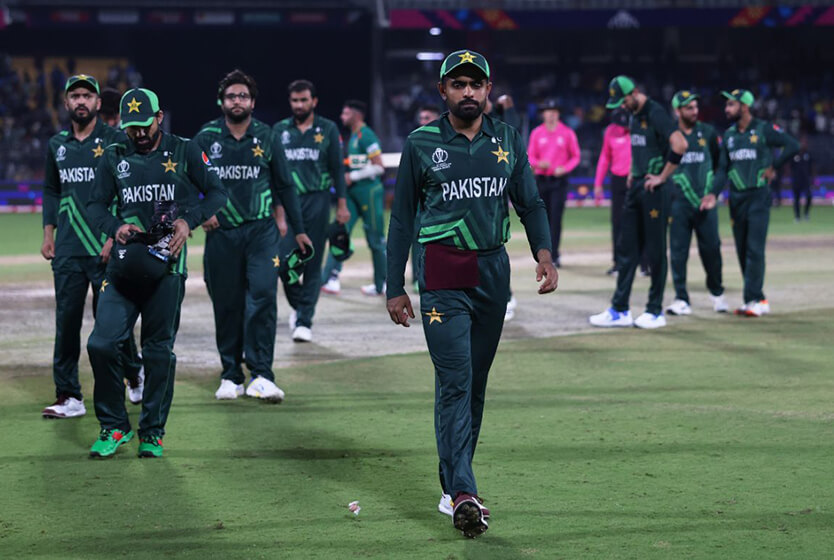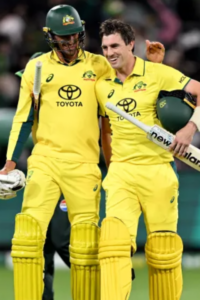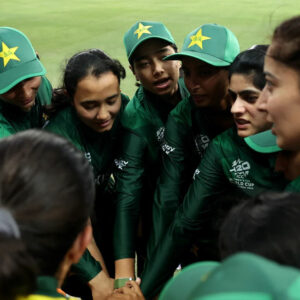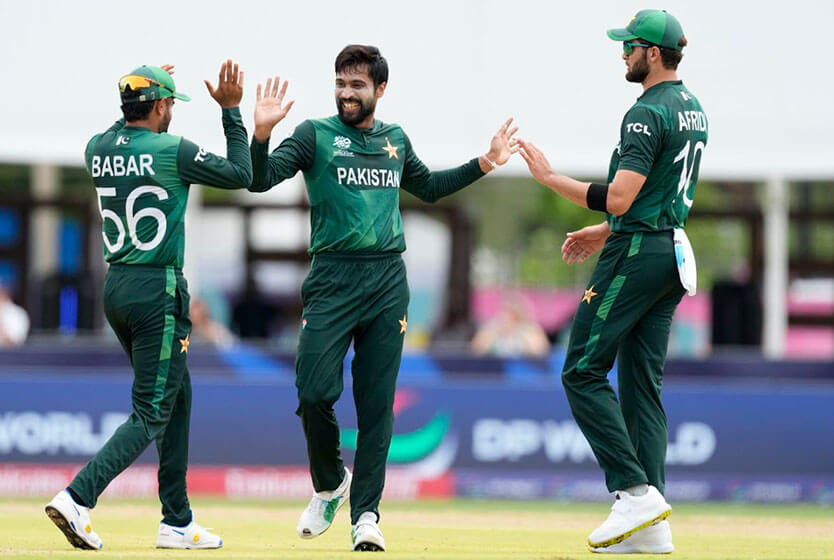
Pakistan Cricket: 2023 Wrapped, Top Artist – Uncertainty
At the start of this year, during the several home games Pakistan played against New Zealand, everyone (including me) believed that this was Pakistan’s best and most settled team to go to a World Cup since 1999. On paper, this team was perhaps better than the one that lost the semi-final of the 2011 World Cup, with a settled opening pair, a world-class number 3, and a pace-bowling attack that had garnered the world’s respect. Perhaps it was time to avenge the defeat of Mohali 2011.
However, things started to fall apart, as they often do with Pakistan Cricket.
Pre-World Cup
We “Need” Mickey Arthur
From December 2022 to April 2023. Pakistan played a Test, 3 ODIs, and 7 T20Is. During that period, Pakistan did not have a settled coaching staff. Najam Sethi, who had taken over the PCB as the chairman of the Management Committee, made it clear that Saqlain Mushtaq was on his way out once his tenure ended in February. Interim coaches would take over for the Afghanistan series in April. Meanwhile, the chairman desperately sought the services of Mickey Arthur.
This was not because Mickey Arthur was cricket’s Alex Ferguson or a coach in extremely high demand around the world. Rather, it was because the interim chairman had worked with him back in 2016-17, and he wanted to work with him again. Why did it take 4-5 months? Well, Mickey Arthur knew the PCB quite well. Being one year into his four-year contract with Derbyshire, he was reluctant to give up the steady job he already had for one he had no surety about. After all, PCB and consistency are worlds apart.
Najam Sethi wouldn’t take no for an answer, however, and eventually, a compromise was reached. Mickey Arthur was appointed as Pakistan men’s team director, but he was allowed to coach Derbyshire as well. He would only join the team partially for the Asia Cup and then the World Cup after the English domestic season finished. To put it short, Najam Sethi allowed him to take on the job even when Pakistan was clearly his second priority.
Management Committee? What is that?
When Shehbaz Sharif took over the reins of the country from Imran Khan, among his earliest decisions was to reinstate PCB’s 2014 constitution and appoint Najam Sethi, the head of the committee that would do that. Theoretically, the management committee’s main tasks were to finalize the new domestic cricket structure according to the 2014 constitution and then hold elections for the PCB chairmanship.
After a lot of pondering and discussions with ex-cricketers, the first step was taken, and the new domestic system was announced after prolonged delays. As mentioned earlier, Pakistan cricket and consistency are worlds apart, so the six associations system, set up by the trio of Imran Khan, Ehsan Mani, and Wasim Khan, was binned after just three years, and a new “old” system was set up.
Onto the second task of the management committee (MC): to hold elections in the PCB. After failing to do so in their stipulated 120 days, the MC was granted an extension of 4 weeks. Conflict of interest queries also arose, as the candidates in some regional associations were already part of the management committee to oversee the electoral process. Another conflict of interest saga was that Haroon Rasheed, who was part of the Sethi-led MC, was also appointed as an interim chief selector. PCB utilized a creative solution to resolve this. According to a PCB statement: “It was agreed that when matters pertaining to the performance of the selection committee are discussed and debated at an MC meeting, Haroon Rasheed will recuse himself and leave the room till such time that the agenda point has not been conclusively addressed.” Innovative indeed.
Hosting the Asia Cup
The chairman of the Asian Cricket Council, Jay Shah, had announced Pakistan as the host of the 2023 Asia Cup. However, closer to the tournament, Jay Shah, also Secretary BCCI, said India would not travel to Pakistan for the Asia Cup due to obvious political reasons.
Therefore, Najam Sethi and the PCB leadership agreed to a hybrid model of holding some games in Sri Lanka and other games in Pakistan – or rather, a few games in Pakistan and the rest in Sri Lanka. After weeks of negotiations, it was decided that less than one-fourth of the games would be played in Pakistan. This was quite an odd format. It was understandable that India’s games couldn’t be in Pakistan, but a number of games not involving India were also scheduled for Sri Lanka, presumably to conserve travel costs and minimize logistical complications.
However, this schedule was particularly harsh on Pakistan. Already playing a series against Afghanistan in Sri Lanka, they had to return to Multan for the Asia Cup opener, then go back to Sri Lanka to face India, then again head back to Lahore to face another team before returning to Sri Lanka for the rest of the tournament. In the lead-up to a World Cup, this was hardly an ideal situation.
Going 10 Years Back
In Harsha Bhogle’s words: “We often used to say – Mondays, Wednesdays, and Fridays, Najam Sethi is Chairman PCB. Tuesdays, Thursdays, and Saturdays, Zaka Ashraf is chairman, and on Sunday, it’s a debate on what it should be the next week.”
Well, those times were almost back. PPP and PMLN were part of the governing alliance of Pakistan, and PPP suddenly remembered that it was agreed that they would appoint Zaka Ashraf, so the merry-go-round started again. Najam Sethi would put out a tweet saying he doesn’t want to be the bone of contention between these parties, eventually stepping down.
Since then, Zaka Ashraf has taken charge of PCB’s MC. He began his tenure by publicly stating that he was not happy with the agreed-upon hybrid model of the Asia Cup but also made it clear that he could not do anything just before the tournament started – rendering his point of view redundant.
Would Pakistan Travel to India for the World Cup?
When he was the chairman of PCB, Ramiz Raja had stated that if India wouldn’t travel to Pakistan for the Asia Cup, Pakistan wouldn’t travel to India for the World Cup. It was an admirable stance, but he would later himself go there as a broadcaster.
When Najam Sethi took over, he was of the same point of view but wanted to talk with the BCCI and sort things out, which he did, but he couldn’t quite gain anything from that. By the time Zaka Ashraf came to the fore, the matter for the Asia Cup was already sorted, so he agreed that Pakistan would go to India. As expected, Pakistan had to concede their stance.
After that, the foreign office and the government wanted to evaluate Pakistan’s participation in the mega event. A committee was set up under then-foreign minister Bilawal Bhutto to take the call on the team’s participation in the World Cup. After some pondering and discussions, they at last gave the go-ahead.
There would be more bumps along the way. Pakistan had to cancel a pre-tournament bonding session in Dubai because they were not granted visas for India on time. Pakistan were the last team to obtain visas for the World Cup. Meanwhile, Pakistani fans and media personnel didn’t receive a positive response either. Journalists eventually were allowed to go to India halfway through the tournament, while Pakistan fans, for the most part, didn’t receive visas.
The “Pakistan Way”
The World Test Championship 2021-23 cycle was Pakistan’s best chance at qualifying for the final. The schedule in this cycle was very favorable as Pakistan played weaker teams away, i.e., West Indies, Bangladesh, and Sri Lanka, while playing stronger teams like Australia, New Zealand, and England at home.
However, Pakistan lost crucial points to West Indies by losing one of the two Tests and then failed to capitalize on home advantage by preparing roads for the home Tests as Pakistan failed to win any Test at home, losing four, including a 3-0 whitewash by England.
After drawing the New Zealand series 0-0, during the summer, Pakistan played two away Tests against Sri Lanka to get the next cycle of the World Test Championship. There, we saw a glimpse of “The Pakistan Way.” Some say it was the brainchild of Grant Bradburn and Mickey Arthur; however, the term was coined back when Saqlain Mushtaq was Head Coach. Another take on that was after being the victims of Bazball, Pakistan decided to adopt that kind of batting in Tests. Whatever its origin, the Pakistan Way was entertaining – there are no doubts about that.
Central Contracts
Amongst all this, the players negotiated with the board regarding the new central contracts. These talks continued for four months; the players played the series against Sri Lanka and Afghanistan, as well as the Asia Cup and the World Cup, without salaries.
The contract terms were finally agreed upon after lengthy negotiations before the team left for the World Cup. Reportedly, Babar Azam, Mohammad Rizwan, Shaheen Shah Afridi, and Shadab Khan played a pivotal role in the new contracts. The earlier negotiations saw a historical rise in the salaries of cricketers and also saw them get 3% of a share in the ICC funding coming into the PCB.
Women’s Team, An Afterthought
Ramiz Raja announced a Women’s T20 League during the Pakistan Junior League opening ceremony. However, nothing concrete was done about it except for three exhibition games during the PSL. After that, two chairmen came, but no one said anything concrete about the Women’s T20 League.
Launching the league now looks far-fetched, as the women’s national team has been playing without a proper head coach for more than a year. The last time Pakistan’s women’s team played under a proper coach was in July/August 2022. Since then, two interim coaches, Saleem Jaffar and Mohtashim Rasheed, have coached Pakistan. The team’s bowling coach is also the chief selector for the Women’s team.
Asia Cup
The hybrid Asia Cup’s preparation was chaotic from an administrative point of view; however, the tournament itself was no less.
During the Asia Cup, Colombo saw rainfall for about a week, so it was debated between the boards and the ACC to shift the games to Hambantota, and the ACC sent the mail as well to confirm the shift to Hambantota. However, the mail was retracted later as the Indian team reportedly did not like the accommodations there. ACC took this decision to play the Super 4 games in Colombo unilaterally and announced it to the stakeholders without consulting with the hosts, PCB.
The rain did not affect many games. However, to still prepare for it, it was decided that a reserve day would be kept for only the India-Pakistan game – just to be clear, this was just another Super 4 game, not a knockout. That reserve day was eventually put to use and proved very costly for Pakistan. Naseem Shah and Haris Rauf suffered injuries, with Naseem Shah being ruled out of the World Cup and Australia series as a result.
The Drama Continues During the World Cup
Throwing the Team Under the Bus
During the 2023 World Cup, the Pakistan Cricket Board issued a press release that effectively threw captain Babar Azam and the chief selector under the bus, saying that they were given full autonomy during the selection process and that the board would take decisions considering Pakistan cricket’s best interests after the tournament. This was an obvious matter understood by all – but a media release saying the same during the World Cup after a couple of losses piled pressure on the team.
Conflict of Interest
In a country like Pakistan, conflicts of interest are routinely ignored. For example, the interim Punjab Sports Minister is also the current men’s chief selector.
This happened after a video by journalist Mubasher Luqman, who claimed that a company named Yazoo International was listed in the UK, and its three directors were then-chief selector Inzamam-ul-Haq, player agent Talha Rehmani, and Mohammad Rizwan. Inzamam-ul-Haq was asked to meet the chairman about this.
Eventually, a committee was formed, so Inzamam-ul-Haq stepped down while the PCB investigated the matter. He later clarified that Yazoo International was formed during the pandemic to sell products but never took off. He expressed a desire to return as chief selector after the investigation – but he was shortly replaced by the incumbent, Wahab Riaz. At the same time, no details have yet emerged about the investigation.
Chat Leaked!
A conversation between COO PCB Salman Naseer and Babar Azam was aired by a TV channel without his permission. Former cricketer Rashid Latif had accused Zaka Ashraf and others in PCB of ignoring Babar Azam’s messages and calls after the infamous press release.
In response, a chat between Babar Azam and Salman Naseer was leaked to a sports journalist and aired on TV. Azhar Ali, a participant of the panel on the TV show, raised concerns about the ethics of publicly sharing something like this. Later, the show host would issue a public apology and accept that the screenshot of the chat shouldn’t have been shared – but the damage was done.
It has been rumored that Babar Azam may take some legal action on this matter, but nothing official has emerged about this until now.
Post-World Cup Hiatus
The Typical Captain Change
After lengthy rumors about what would happen with the leadership of the Pakistan team after the World Cup debacle, Babar Azam resigned from the captaincy in all formats through his personal social media accounts.
A brief while later, the PCB made the new captaincy announcements. Initially, they announced on social media that Shan Masood would be the red-ball captain while Shaheen Shah Afridi would be the white-ball captain. However, this was quickly deleted and amended to reflect that Shaheen Shah Afridi would only be the T20I captain, with the ODI captain to be announced at a later date. Pakistan don’t play any ODIs till November 2024.
Meanwhile, according to the PCB press release, the board asked Babar Azam to continue as Test captain and leave white-ball captaincy. Then, of his own accord, Babar left captaincy in all three formats. All the developments took place very quickly.
New Appointments
Since the PCB management committee has no authority to make long-term decisions, they could not remove the coaching staff, although they desperately desired to do so. Thus, they changed the portfolios of Mickey Arthur and Grant Bradburn and asked them to work at the NCA.
The PCB would later announce Mohammad Hafeez as the director of the men’s team – effectively replacing Mickey Arthur. However, no updates have been given about Mickey Arthur and whether he is still employed with the board. He has, meanwhile, gone back to continue work at Derbyshire. Unofficially, director and head coach roles appear to have been merged, with no head coach being announced to take over from Grant Bradburn. Thus, Hafeez is effectively the director/head coach.
Morne Morkel, meanwhile, announced his resignation soon after the World Cup with a few months remaining on his contract. The PCB signed up Umar Gul as the fast-bowling coach, while Saeed Ajmal would take up spin-bowling coaching duties.
The changes continued to be rung: Sohail Tanvir and Mohammad Yousuf were appointed as Selector and Head Coach at the Under-19 level, with Pakistan scheduled to play the Under-19 World Cup in early 2024. What’s positive about these changes is that Pakistan has appointed recently retired players rather than players from the 70s/80s or the 92 batch.
That wasn’t all, though – there was time for some more drama. Chief Selector Wahab Riaz (himself among the new appointments) announced that he would be utilizing the services of a few cricketers as consultants for selection. Among his choices was Salman Butt – an announcement that was met with fury from legions of Pakistan cricket fans and the international cricketing media at large. Wahab Riaz would later retract this decision, saying that he didn’t appear to want to be giving favors to someone he knows well. Kamran Akmal and Rao Iftikhar Anjum are currently serving as consultants for selection, while the retiring Asad Shafiq will also take up the role.
NOC Policy Conflicts
Wahab Riaz’s first press conference as the chief selector was mostly about Haris Rauf pulling out of the Test series in Australia despite being guaranteed by the management that his workload would be managed. Wahab stated that he had originally agreed to play but pulled out at the last moment, whereas other media reports claim that he wasn’t keen on playing due to a lack of First Class cricket recently. The Chief Selector openly remarked in the presser that this decision would damage Pakistan Cricket, and that Haris Rauf should have made a sacrifice for Pakistan’s sake.
In the meantime, Haris Rauf has gone to play the Big Bash League after a prolonged delay in receiving an NOC (no objection certificate). The Melbourne Stars, who signed Haris Rauf, heavily marketed his impending arrival. Reports that he may not receive an NOC were met with dismay. Usama Mir and Zaman Khan had also been signed up for BBL duty. The trio would eventually receive partial NOCs after the tournament had begun, only being allowed to play 4-5 games each as they were required to return to Pakistan for a T20I team camp ahead of the upcoming New Zealand series.
There have been reports that this could just be the start of the NOC issue – a problem that has long plagued Pakistan cricket. Many Pakistani cricketers are in demand in various T20 leagues, and since they don’t play the IPL, it’s only natural to look for opportunities elsewhere. Shaheen Shah Afridi, Shadab Khan, and Azam Khan have been signed up for the ILT20, although it has been rumored that Shaheen Shah Afridi will skip the tournament. It’ll be interesting to see if the others receive NOCs.
Ahead of the National T20, there was news that the PCB wanted all players who wanted to play T20Is to participate in the tournament if they were available. This led to a reported tiff with Imad Wasim, who wanted to play the Abu Dhabi T10. With him being in the plans for the T20 World Cup, this was perhaps seen as a problem – which Imad resolved by announcing his retirement from international cricket. He then took part in the Abu Dhabi T10 alongside others such as Asif Ali and Mohammad Amir, who aren’t in the T20I team’s plans at the moment.
Team Director Mohammad Hafeez discussed NOC matters in a lengthy press conference, saying that players would be allowed to play in T20 leagues but that their workloads would be closely assessed to ensure they were fit for Pakistan duty. He was also clear in stating that centrally contracted players should be available to play for Pakistan in all formats.
Injuries to End the Year
Meanwhile, Pakistan’s tour of Australia hasn’t gone well so far. Before the first Test, Abrar Ahmed pulled up with a leg injury, being ruled out of the first 2 Tests. Khurram Shehzad, who impressed in the first Test, was ruled out of the rest of the tour after suffering a stress fracture in one of his ribs and an abdominal muscle tear. Noman Ali suffered a finger injury when he arrived in the country and was unable to train ahead of the first Test. He then suffered appendicitis before the second Test and was ruled out of the tour. This compounded an already bad situation for the tourists who were without Naseem Shah due to his shoulder injury and Haris Rauf, who had earlier opted out.
A Historic Year for the Women’s Team
Top Performances & Impressive Results
The start of the year for women’s cricket was quite shaky with the Australia tour, where Pakistan lost all the games. However, towards mid-February, things started to get better.
Muneeba Ali became the first cricketer from Pakistan to score a WT20I century. Pakistan won their first game of the T20 World Cup against Ireland.
After a couple of weeks, among PSL fever in the country, three exhibition games were held, although this was when an entire Women’s T20 League was planned earlier. In these three games, local players got the opportunity to rub shoulders with global stars like Chamari Athapathtahu and Danni Wyatt. According to many players, it was quite helpful for the local players who got this opportunity, which was later reflected in their performances.
Later, the bumper home series against South Africa took place. Pakistan whitewashed them in the WT20Is. The performances of Aliya Riaz, Nashra Sandhu, Sidra Amin, and Muneeba Ali were especially instrumental in this series. However, they lost the WODI series and managed just one win.
In an away tour of Bangladesh in October, Pakistan only managed to win 1 WODI and WT20I on the sluggish tracks of Bangladesh, who had also recently defeated India. The 2nd WODI was lost only in a Super Over, though, so it was a closely fought series.
The women’s team toured New Zealand at the end of the year and registered historic wins. They clinched the first WT20I to register their first victory against New Zealand, also becoming the first Asian side to win a WT20I in New Zealand. They also won the next match to record a stunning series win. The WODIs didn’t quite go to plan, with Pakistan suffering a heavy loss in the first match. A narrow loss followed in the second match, although there was some questionable umpiring against the visitors. This was Fatima Sana’s captaincy debut, and she delivered on her promise with a classy 90* under pressure. Pakistan got a consolation victory in the final WODI, sealing a thrilling Super Over win.
Defeated the Kiwis, But Who Saw It?
During this historic tour, something unusual unfolded back home in Pakistan. Fans tried to find a legal way to watch the series in Pakistan, but there was none – illegal streams were the only accessible method as no broadcaster showed the series in the country. Some blame the NZC, some blame the broadcasters, and some blame the PCB. Whoever is at fault should have ensured that Pakistan saw their women’s team on a historic tour.
Conclusion
The chaos never stops at Pakistan Cricket – it runs 24/7, especially around a major tournament. The start and the end of this year were polar opposites. The year began with huge expectations and hopes, but nothing went to plan – at least not for the men’s team, as they were dumped out of the World Cup before the suffering began in Australia. Instead, it was the women’s side that surpassed expectations and delivered historic moments and victories.
It seems like Harsha Bhogle was right when he said that when Pakistan come at favorites, they find ways to play worse-than-expected cricket, and when they are down and out and considered underdogs, they will play cricket like you’ve never seen before and rise from the ashes. As for the board… the lesser said, the better!
The opinions expressed solely belong to the writer and do not necessarily reflect the views of Grassroots Cricket.







Leave a Reply